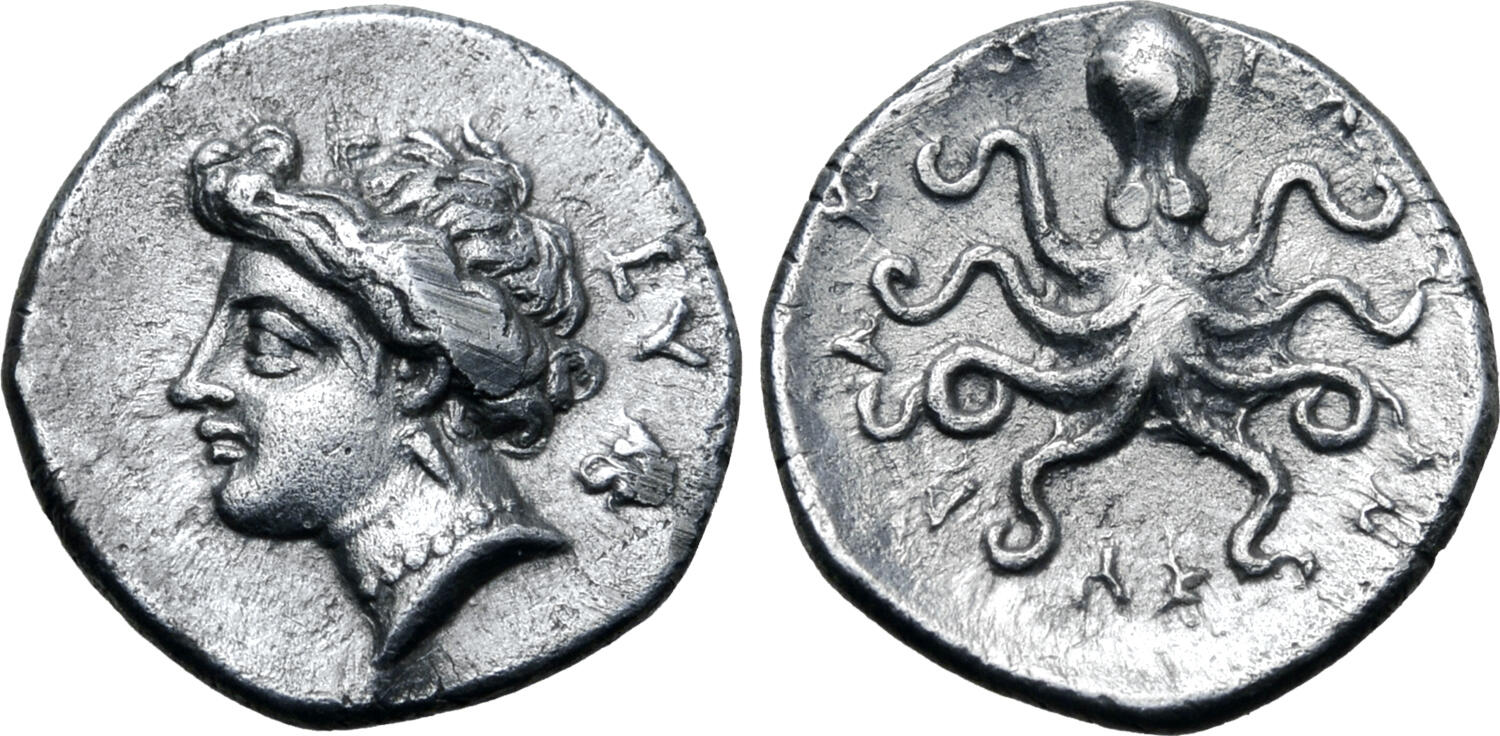Syracuse ('third democracy'), silver, litrae (Arethusa/octopus) (320-317 BCE)
From SILVER
(Redirected from S 1591 - Syracuse ('third democracy'), silver, litrae (320-317 BCE))
320 BCE - 317 BCE Silver 30 kg
Description
| ObverseInscription or printing placed on the obverse.: | Head of Arethusa to left, hair in sphendone, EY and lion's head to left behind |
| ReverseInscription or printing placed on the reverse.: | ΣΥΡΑΚΟΣΙΩΝ around (Greek).Octopus |
Mint and issuing power
| MintIdentifies the place of manufacture or issue of a numismatic object.: | Syracuse | Ancient regionAncient region.: | Sicily | Modern countryModern country: Italy | AuthorityIdentifies the issuing power. The authority can be "pretended" when the name or the portrait of X is on the coin but he/she was not the issuing power. It can also be "uncertain" when there is no mention of X on the coin but he/she was the issuing power according to the historical sources: | Timoleon of Corinth (411-337 BCE) |
Chronology
| FromIdentifies the initial date in a range assigned in a numismatic context. | 320 BCE | toIdentifies the final date in a range assigned in a numismatic context.. | 317 BCE | PeriodTime period of the numismatic object.: Hellenistic 323-30 BC |
Physical description
| MetalThe physical material (usually metal) from which an object is made.: | Silver |
Median weightMedian of the weights of numismatic objects (in grams). in grams | 0.70 | DenominationTerm indicating the value of a numismatic object. Examples: tetradrachm, chalkous, denarius.: | litra |
StandardStandard.: |
References
| Die study referencePublication of the study: | Hochard 20221Hochard 2022, p. 72, n° 36 | ||
| Coin series referenceReference to coin series study: | Sear I2Sear I, n° 966, HGC 23HGC 2, n° 1382 | ||
Obverse dies distribution
| FrequencyFrequency of specimen in distribution. ᵖ | Number of obversesNumber of obverse dies. ᵖ (o) | % (o) | Number of coinsNumber of coins. (n) | % (n) | Die nameName(s) of the die(s). |
| 1 | 1 | 50 | 1 | 8.33 | 64 |
| 11 | 1 | 50 | 11 | 91.67 | 65 |
| Total | 2 of 2 | 100 | 12 of 12 | 100 |
Reverse dies distribution
no distribution is available
Quantification
| Number of obversesNumber of obverse dies. ᵖ (o) | 2 | Number of singletons (o1)The number of singleton coins. ᵖ | 1 |
| Number of reverse diesNumber of reverse dies. (r) | 4 | Number of coinsNumber of coins. (n) | 12 |
| Coins per obverse dieNumber of coins per obverse die. (n/o) | 6 | Coins per reverse dieNumber of coins per reverse die. (n/r) | 3 |
| Reverse per obverse ratioRatio of obverse dies divided by reverse dies. (r/o) | 2 | Percentage of singletons (o1)number of coins (n) divided by the number of singletons (o1) ᵖ | 50 % |
| Original number of dies (O) (Carter 1983 formula)The estimation of the number of coins according to Carter 1983 ᵖ | 2.15 | Coins struck if 20,000 as average productivity per dieCoins made if the average productivity for obverses (according to Carter) is 20,000. ᵖ | 43,000 |
| Original number of dies (O) (Esty 2011 formula)The estimation of the number of coins according to the singleton formula in Esty 2011 ᵖ (O) | 2.4 | Survival rate if 20,000 as average productivity per dieSurvival rate if average productivity is 20,000. ᵖ | 0.00028 |
| Coverage (o = % of O) (Esty 1984 formula)Esty 1984 - coverage (% of O) ᵖ (o = % of O) | 91.67% | Die productivity if survival rate 1/2,000Average productivity if survival rate is 1/2,000. ᵖ | 11,162.79 |
| Weight of silver (in kg) if 20,000 coins per die (O = Carter formula)Carter 1983 * Median weight * 20000 (*10 if gold or electrum) ᵖ | 30 kg <br /> 30 kg | Die productivity if survival rate 1/5,000Average productivity if survival rate is 1/5,000. ᵖ | 27,906.98 |
Remarks
References
- ^ Hochard, Pierre-Olivier (2022), "Le monnayage d'or et d'argent de Syracuse sous Timoléon et la "Troisième démocratie" ", Revue Numismatique, 179, p. 17-81.
- ^ Sear, David R. (1978), Greek coins and their values. Vol. I, Europe, London, xl, 316 p.
- ^ Hoover, Oliver D. (2012), The Handbook of Greek Coinage Series. 2. Handbook of the Coins of Sicily (Including Lipara). Civic, Royal, Siculo-Punic, and Romano-Sicilian Issues. Sixth to First Centuries BC, Lancaster-London, 489 p.
